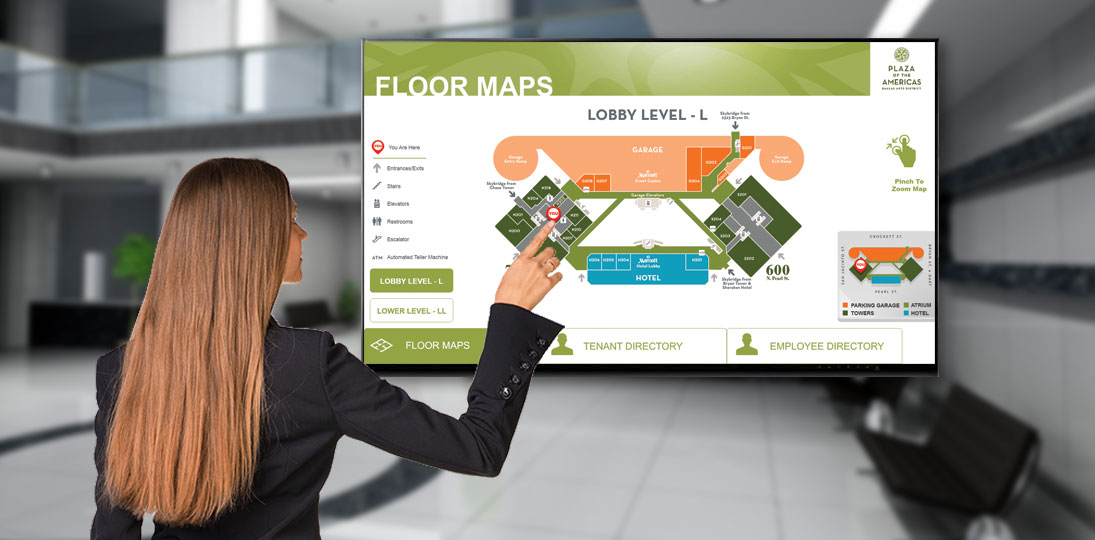Digital wayfinding is the modern way to help people get from point A to point B. We’re not talking about simply replacing static physical maps with static digital ones, we’re talking about interactive wayfinding. People use their mobile devices every day to find places on their own, and your wayfinding signage needs to give them a similar experience.
The Basics of Digital Wayfinding
Touchscreen maps, either on interactive digital signs or interactive wayfinding kiosks, offer a “self-service” approach towards the problem of helping people navigate a space, an area, a building or a campus.
By putting the search process in their hands, people feel more in control, which leads to a more positive visitor experience for them. It also saves your organization time and money, since there will be fewer people asking for directions from staff. In fact, with the proper combination of signage and wayfinding, you might even be able to eliminate that lobby information desk altogether.
Maps can not only show “you are here”, but can actually draw out the best route to the intended destination. Some wayfinding digital signage can even allow visitors to print the specific directions they need, or have them sent to their phone or tablet by using a QR tag or text messaging. High-quality pictures of landmarks along the way can also make navigation easier.
Wayfinding signage systems can include directories that are searchable according to different audience needs – people, places, departments, events and so on. And you’ll need to think about how that directory information gets updated. Can it be entered manually into an Excel sheet or even a custom web UI? Can you use XML, JSON or connect to a database, so the system adjusts automatically? If a database, is it a custom one or can you use one that already exists?
Designing Wayfinding Signage
When thinking about wayfinding signage design, you can have flat design, or titled on an axis, or 3D maps. You’ll want to match your branding style, but you also have to think about everything that relevant to a visitor, and present the information is the most logical, intuitive way.
Use floor maps for specific buildings, campus maps for larger areas and integration with something like Google Maps for even larger coverage areas. You also have to keep ADA regulations in mind when designing both the content and placing the physical signs or kiosks. For example, is the entire display mounted at a height that makes it easy to reach in a wheelchair? If not, you’ll want to add buttons at the bottom of the display.
Wayfinding Signage System Team
To get a comprehensive digital wayfinding system up and running, you’ll need a team. More than likely, it will include someone to manage the whole project, a graphic designer, a developer or coder, input from marketing to make sure everything fits comfortably within brand standards, and someone from facilities to supply and verify maps and directory entries.
Your IT folks will also likely be involved to implement the wayfinding system and integrate it with your directory or database. In most cases, your digital signage provider (hopefully, Visix!) will do the creative and coding work, partnering with your marketing, facilities and IT staff to get it launched.
Combine Signage and Wayfinding
And don’t forget, wayfinding digital signage is just that – digital signage. That means you can show additional screen content like weather, date and time, news (in a ticker or a separate content zone), shuttle or traffic info, messages about the facility and so on. By using touchscreens, you increase your digital signage real estate while at the same time giving people something they want and need.
Also, you can promote your wayfinding on your traditional digital signs, and vice versa. If you have your wayfinding created in HMTL5 or some other responsive platform, you can integrate it into an app, or let people download it onto mobiles using a simple QR tag or URL shown in messages on screens throughout your facility. If you don’t have the budget for touchscreen kiosks, you can still offer the downloadable version.
Wayfinding is one of the most useful things you can provide your audience, and a well-planned digital wayfinding solution can also provide a little “wow factor” for visitors to your facilities. Your goal is to make their lives easier, save them time and improve the visitor experience. Digital wayfinding done right can do just that.
For more about interactive wayfinding:
